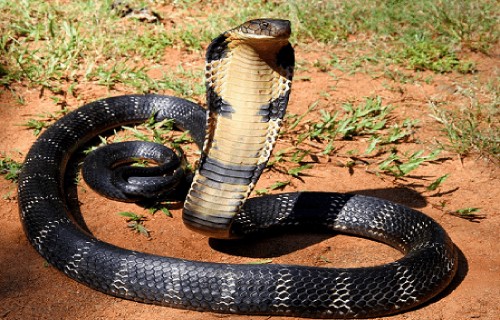
We sincerely hope that you thoroughly enjoy this article about 4 Remarkable Reptiles of India. Certainly, the area has many other reptiles to choose from, and some of them can be quite impressive in their own right, but we have selected these as a good cross sample.
Creatures such as these come in many shapes, sizes, colors, and forms, each more amazing than the one before, it seems. And each of them has their own role to play in their local ecosystems, so remains deserving of our respect and appreciation, like all forms of life.
Reticulated Python
Reticulated Python Facts
- Leading off this article about 4 Remarkable Reptiles of India is the incredible snake known as the Reticulated Python.
- The amazing animal with the distinctive name is a particularly large variety of python. In fact, although not the most heavily built, it currently ranks as the longest snakes on earth. That impressive fact alone makes the creature worthy of note.
- Just as with other types of pythons, though, this truly amazing animal feeds as a constrictor, since the enormous snake has no venom. In addition, fully grown adult individuals become more than powerful enough to kill a human being.
- Such attacks on human beings by this particular species remain virtually unknown, however, despite what many people tend to believe. Though this rarely occurs, when it does, it usually happens in specific circumstances.
- These include if the snake has been removed from its natural habitat, or that habitat, frequently located near water, is disturbed. Related to this is the fact that the awesome Reticulated Python also ranks as a rather excellent swimmer.
- This truly remarkable trait ranks as one that the incredible reptile further shares with many of its related species. Among this particular example of constrictor, however, adult specimens even occasionally venture far out at sea.
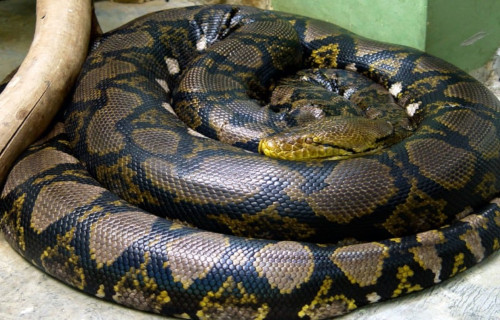
CCL: http://bit.ly/2IjEG4n
Reticulated Python Physical Description
Most notably, the Reticulated Python fully earns its designation as the longest snake known to man. To the amazement of some, exceptional adult specimens sometimes approach 23 ft (7 m) in length. These truly gigantic individuals do not occur often, though.
Typical adults actually measure around 20 ft (6.1 m) in total length, and the usual mature individual further weighs about 165 lb (75 kg). The species presents no discernible sexual dimorphism, however, with both genders possessing the same appearance and size.
Its markings remain highly distinctive, and typically consist of intricate geometric patterns. These patterns also combine a quite wide variety of color shades. The exact colors vary according to the geographical range, sometimes making the snake difficult to identify.
This great variation in coloring among the King Cobra also represents an evolutionary adaptation to the local environment. Its remarkable natural camouflage also serves to make this highly dangerous animal almost invisible in its respective habitats.
- Kingdom: Animalia
- Phylum: Chordata
- Class: Reptilia
- Order: Squamata
- Family: Pythonidae
- Genus: Python
- Species: P. reticulatus
Reticulated Python Distribution, Habitat, and Ecology
The Reticulated Python appears to be endemic to quite a wide range. This area extends across much of Southeast Asia. In fact, this range extends from India, Bangladesh, and Laos, through Indonesia. It also includes numerous island countries, such as the Philippines.
In addition to its other impressive characteristics, it remains highly adaptable to its surroundings. As a result of this ability, it thrives in a rather wide variety of habitats. However, these regions of habitation typically include woodlands, grasslands, and forests.
But even within that native range, this fascinating reptile remains quite versatile in its habitat requirements. Amazingly, the enormous animal frequently inhabits rivers, lakes, and even large streams within these areas, being an excellent swimmer.
It feeds almost exclusively as an ambush predator, like other known types of constrictors. The diet, however, understandably varies, depending upon its location. This commonly includes such prey as larger mammals, but smaller specimens will feed on birds and rodents.
This species, like other snakes, evolved as oviparous. A female Reticulated Python will lay anywhere from 15-80 eggs per clutch, after mating. These then require an average of about 88 days to hatch. Newly hatched specimens average about 2 ft ( 61 cm) in length.
Cantor’s Giant Softshell Turtle
Cantor’s Giant Softshell Turtle Facts
- The next creature appearing in this listing of 4 Remarkable Reptiles of India is the incredible Cantor’s Giant Softshell Turtle.
- The magnificent and distinct reptile quite easily ranks as one of the largest extant species of turtle known to man. This truly unique animal bears this common name, among others, in honor of Theodore Edward Cantor.
- Somewhat uniquely, a great deal of confusion currently exists concerning the exact maximum size of this turtle. That’s understandable though, given that this species spends approximately 95% of its life buried in the sand or mud.
- Amazingly, once there the implacable reptile also generally remains virtually motionless. During this time, though, most commonly only its mouth and eyes remain exposed. Typically, this distinctive wonder of nature only emerges twice per day.
- Regrettably, the population of the Cantor’s Giant Softshell Turtle appears to be in decline. For that reason, the IUCN lists the species as Endangered, on its Red List. The primary threats to its existence also seem to be habitat loss and hunting.
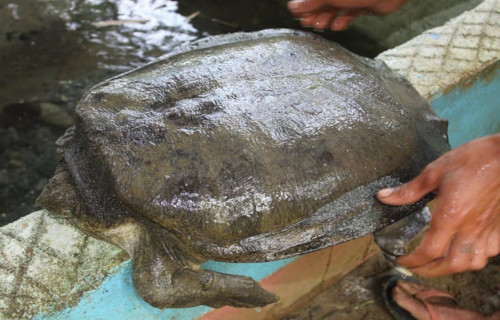
CCL: http://bit.ly/2QZT99x
Cantor’s Giant Softshell Turtle Physical Description
The Cantor’s Giant Softshell Turtle forms a species of freshwater turtle. Its maximum confirmed carapace length measured 39 in (100 cm). Claims of specimens measuring as much as 6 ft (1.9 m) in total length also exist, but these remain unsubstantiated.
The carapace also has a relatively smooth texture, with this typically presenting an olive green color. Yet immature individuals often display dark mottling and yellow coloring. This appears primarily present around the edges of the carapace.
The amazing turtle also has a broad skull, with relatively small eyes. These appear located close to the tip of the snout. When it reproduces, the female typically lays between 20-28 eggs at a time, between the months of February and March.
- Kingdom: Animalia
- Phylum: Chordata
- Class: Reptilia
- Order: Testudines
- Family: Trionychidae
- Genus: Pelochelys
- Species: P. cantorii
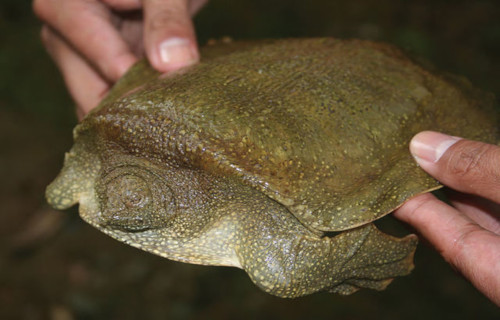
CCL: https://bit.ly/31RL9iJ
Cantor’s Giant Softshell Turtle Distribution, Habitat, and Ecology
The amazing Cantor’s Giant Softshell Turtle primarily occurs in the countries of India, Burma, and Thailand. Individuals can also be found in Cambodia, Vietnam, China, and Java. On occasion, individuals are spotted in neighboring areas as well.
It remains undetermined if these are indigenous to these areas, however, leading to even more confusion. The remarkable reptile lives almost exclusively in freshwater streams and rivers. These bodies of water must also be relatively slow moving.
Although populations of this species most often live inland, there presently remains some evidence that its range also includes coastal regions as well. Ongoing investigations, however, continue to attempt clarify this situation, to better understand the creature.
The primarily carnivorous turtle also seems to have evolved as a highly effective ambush predator. It feeds primarily on mollusks, fish, and small crustaceans. Specimens occasionally will also consume small quantities of various aquatic plants.
King Cobra

King Cobra Facts
- Placing in the third spot in this compendium of 4 Remarkable Reptiles of India, the King Cobra does so only due to random selection.
- The truly impressive snake remains best known for one outstanding fact. That’s that it ranks as the longest known species of venomous snake known to man. Despite its great length, however, it remains rather surprisingly light.
- But, the common name of this reptile creates confusion, being quite deceptive. That’s because, regardless of its other impressive attributes, it does not qualify as a true cobra. True cobras have decidedly different attributes.
- In point of fact, this remarkable animal actually forms the sole member of its own genus. No other known species even come close to its particular physical qualities. This fact alone also makes the snake of particular interest.
- Finally, this fascinating snake also remains worthy of being considered extremely dangerous if provoked. This status holds true due to a combination of two factors. Those are the toxicity of its venom, and the sheer quantity of venom produced.

CCL: http://bit.ly/2zBWbKi
King Cobra Physical Description
Quite remarkably, the beautiful but deadly King Cobra averages about 13 ft (4 m) in length. Exceptional individuals, however, sometimes attain a length of a much as 18.5 ft (5.6 m). Both measurements far outdistance any other known venomous snakes, though.
Despite its great length, however, the extremely dangerous snake remains a relative lightweight. Surprisingly, this reptile typically averages no more than 13 lb (6 kg) in weight. In point of fact, the heaviest King Cobra on record only weighed 26 lb (12 kg.).
In color, the fabulous reptile also typically presents one of several distinct color patterns. This trait further separates it from most related creatures. These patterns include either an olive-green, tan or black, with yellow bands crossing the body along its length.
- Kingdom: Animalia
- Phylum: Chordata
- Class: Reptilia
- Order: Squamata
- Family: Elapidae
- Genus: Ophiophagus
- Species: O. hannah
King Cobra Distribution, Habitat, and Ecology
The mighty King Cobra evolved as endemic to the forest regions of Southeast Asia. This quite impressive range includes India, Indonesia, and the Philippines. Within that range, individual specimens typically prefer to inhabit rather dense highland forests.
The fabulous creature also primarily preys on other snakes. However, most individuals will also consume small invertebrates. The King Cobra remains classified as diurnal, and primarily hunts during the day. During the night, it remains concealed, unless disturbed.
Despite its exaggerated reputation, this reptile isn’t typically aggressive unless provoked. When this happens, though, it will raise as much as one-third of its body length into the air. Subsequent to that, it will also flatten its head in preparation to strike.
This species also remains capable of delivering multiple envenomings in a single encounter. This further makes the incredible King Cobra stand out, since many, although certainly not all, other poisonous snakes lack this ability to repeatedly poison its victims.
In addition to its other unique attributes, it represents the only known snake that builds nests for its eggs. These it builds using dry leaves and twigs. One mating produces anywhere from 7-43 eggs. Those that survive to adulthood live an average of about 20 years.
Gharial
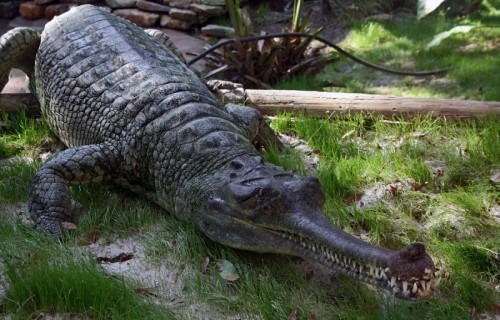
CCL: http://bit.ly/2P4R3Ic
Gharial Facts
- Rounding out these choices for inclusion of 4 Remarkable Reptiles of India is the often-overlooked Gharial.
- The relatively simple term serves as the most often used common name for an impressive variety of crocodilian. This amazing reptile also goes by other alternate names, though, including such terms as the gavial and the fish-eating crocodile.
- The scientific name for it, meanwhile, remains the somewhat tongue-twisting term of Gavialis gangeticus. Regardless of which name one uses to refer to it, however, the remarkable animal represents a highly fascinating species of powerful reptile.
- This creature received its first scientific name as a result of the work of the renowned German naturalist, Johann Friedrich Gmelin, in 1789. That name was later changed, though, at the proposal of another German naturalist, Nicolaus Michael Oppel.
- Though once quite plentiful throughout the entirety of its natural range, its population began declining sharply in the 1930’s. That number has now shrunk to such an extent that the IUCN currently lists it as Critically Endangered on its Red List.
- Its estimated population recently numbered only 235 individuals, putting the magnificent Gharial in a precarious situation. Although efforts to bolster that continue, it faces numerous threats, such as the ongoing effects of climate change.
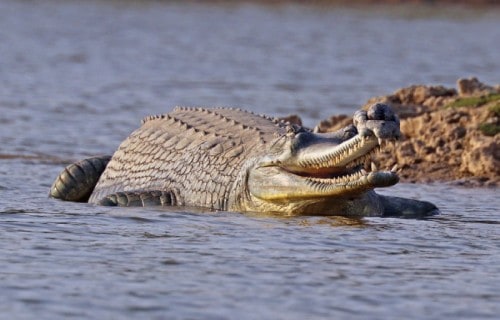
CCL: http://bit.ly/2zBWbKi
Gharial Physical Description
Despite being less well-known than some of its relatives, the fascinating Gharial nonetheless remains a physically impressive species. In fact, this particular reptile represents one of the largest of all known crocodilians, at least in terms of body length.
Like many reptiles, though, this marvel of Nature also displays a moderate degree of the physiological trait of sexual dimorphism. In the instance of this specific animal, that distinctive evolutionary trait manifests itself in terms of sheer physical size.
As a result, the male of the species attains a greater average length than the female. His overall length averages around 20 ft (6 m), while hers averages roughly 14.75 ft (4.5 m). Males also typically weigh slightly more, at about 400 lb (181 kg), against her 350 lb (159 kg).
Typically, the adult Gharial possesses a dark olive color tone, while young ones present a pale olive with dark brown spots or cross-bands. Its stomach, meanwhile, displays a yellowish-white. The back also darkens with age, turning nearly black after around 20 years.
Its most easily and frequently noted divergence from its relatives, however, remains the shape of its snout. This develops as quite elongated, and very thin in relation to the rest of the body. It further has a bulbous structure on the end of the snout, that it uses to hiss with.
- Kingdom: Animalia
- Phylum: Chordata
- Class: Reptilia
- Order: Crocodilia
- Family: Gavialidae
- Genus: Gavialis
- Species: G. gangeticus
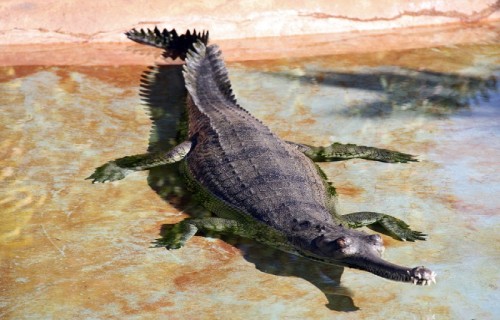
CCL: http://bit.ly/2xQPH8p
Gharial Distribution, Habitat, and Ecology
Although the awesome Gharial once inhabited a significant portion of its part of the world, it now only appears in an estimated 2% of that previous range. This magnificent product of evolution evolved as endemic to the majority of the subcontinent of India, in Asia.
The powerful, but relatively timid reptile also once thrived in all the major river systems of the Indian Subcontinent. Its territory once spanned the rivers of its part from the Indus River in Pakistan across the Gangetic floodplain to the Irrawaddy River in Myanmar.
The gorgeous reptile evolved as perhaps the most highly aquatic of all its relatives. Due to that, its choice of habitat remains dictated by its needs, placing it always either in or near bodies of water. This consists almost exclusively of various rivers in its area.
Individuals spend almost all their time in the water, usually only leaving it to bask themselves in the sun. This activity most commonly takes place in small groups, with a dominant adult male, several females, and multiple young of both genders per group.
Like all its relatives, the Gharial feeds entirely as an active predatory carnivore. The young generally feed on small fish, tadpoles, frogs, and even insects. Adults, however, generally consume fish, which it swallows whole, but occasionally feed on crustaceans.
4 Remarkable Reptiles of India
We truly hope that you have greatly enjoyed reading and learning from this article about 4 Remarkable Reptiles of India. This part of the world just seems to abound with life of all kinds, including reptiles. These few represent on the tiniest handful of species here.
Yet many of the forms of life in this part of the world, like those everywhere else, now find themselves in grave peril. It remains up to each and every one of us to do all that we can to ensure the survival of the varying species sharing the planet with us.
Check out our other articles on 4 Amazing North American Deserts, Sensational Christmas Namesakes of the World, Spectacular Dolphins Throughout Our World
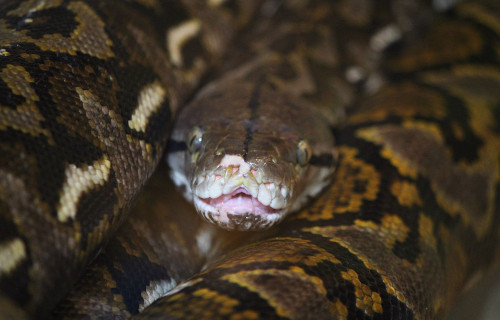
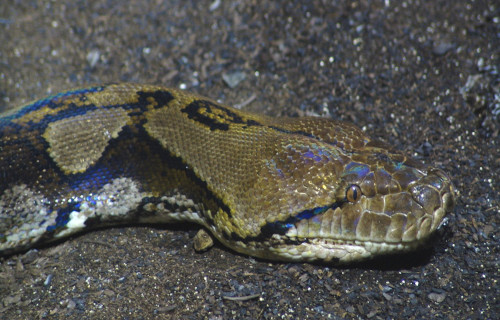
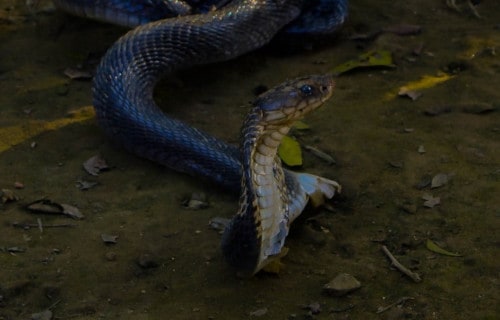









Leave a Reply